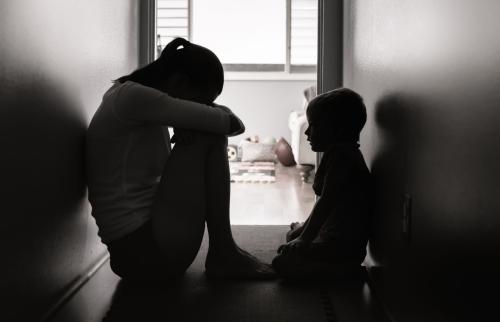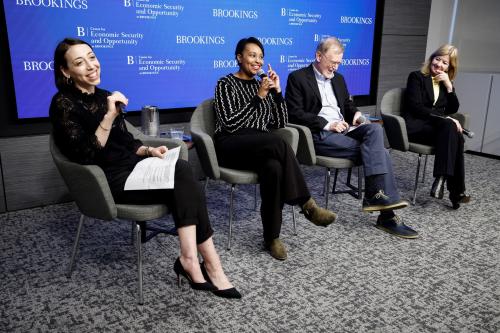This excerpt is reprinted with permission from “The Two-Parent Privilege: How Americans Stopped Getting Married and Started Falling Behind” by Melissa S. Kearney, published by the University of Chicago Press. © 2023 by the University of Chicago. All rights reserved.
The author discussed the findings of her book at an event at Brookings on Sept. 21, 2023 – you can watch the full video here.
The United States today is characterized by tremendously high rates of income inequality that exacerbate the country’s cultural and institutional divides. As the income gaps between those with more and less education and those with higher and lower levels of income have widened, shared experiences and the promise of equal opportunity have eroded. Children growing up in these separate spheres do not have anything close to equal opportunities in life. Children born to highly educated, high-income parents are almost all being raised in highly resourced two-parent homes; they live in safe neighborhoods with well-funded schools, surrounded by high-test-scoring peers; most of them graduate from high school and then enroll in college; a majority of those who enroll in college graduate with a degree. In other words, they are predisposed by virtue of their family background to reaching the milestones that are likely to help them achieve an economically secure life. In contrast, children born to unmarried parents are more likely to grow up in a one-parent household and are statistically less likely to have these resources or advantages. This correlation is exacerbated by the social trappings of American inequality. Children in families with fewer resources (as compared to those who come from having two adults in the home) often live in low-income neighborhoods and attend inferior schools, because they have no other choice. They graduate high school and enroll in college at lower rates. Those who do enroll in college are much less likely to earn a degree.
Closing these class gaps will require many changes in society and vast improvements to a variety of institutions. Economic trends related to inequality will not just reverse themselves if left unchecked. When economic and social conditions reinforce class gaps, closing these gaps becomes increasingly difficult over time. Family structure perpetuates privilege and disadvantage across generations through its effects on the lives of children. While it is more comfortable to talk about elements of inequality, threats to social mobility, and policy interventions that are outside the orbit of family relationships, we need to discuss this metaphorical elephant in the room. This book aims to spotlight how an increasingly unequal economy has led to a class gap in family structure that perpetuates inequality and undermines economic mobility through its effect on children. This book puts a spotlight on the most fundamental institution to society: the family.
Over the past 40 years, there has been a dramatic decline in the share of children living with married parents; this shift has happened largely outside the college-educated class.
In 2019, only 63% of children in the U.S. lived with married parents, down from 77% in 1980. This decline has not been experienced equally across the population. There has been little change, for example, in the family structure of children whose mothers have a four-year college degree: In 2019, 84% of children whose mothers had four years of college lived with married parents, a decline of only 6 percentage points since 1980. Meanwhile, only 60% of children whose mothers had a high school degree or some college lived with married parents, a whopping 23 percentage point drop since 1980. A similarly large decline occurred among children of mothers who didn’t finish high school; the share of children in this group living with married parents fell from 80% in 1980 to 57% in 2019. Figure 1 plots these trends.
Some might argue that placing marriage at the center of a conversation about children is antiquated and unhelpful: Marriage is in many ways less fashionable than it was four decades ago. Marriage rates have fallen significantly in the U.S., including among adults who have children. It’s important to recognize that these changes in marriage patterns are not without consequence for how children are being raised. Data show conclusively that parents are not cohabitating without marriage in a way that remotely accounts for the decrease in two-parent married households. These kids are more often living with one parent. What’s more, data show that these trends are highly correlated with the parent’s education: The share of children living in two-parent homes is 71% when the mother has only a high school degree and 70% when she does not have a high school degree. A much higher share, 88%, of children of mothers with a four-year college degree live in a two-parent home.
Why does this issue matter for kids’ outcomes? Because children who grow up without two parents in their home are at a substantial disadvantage relative to kids who do. That is not to say that children who are raised by a single mother can’t go on to achieve great things. Of course they can, and many do! But there are also mounds of social science evidence that shows how the odds of graduating high school, getting a college degree, and having high earnings in adulthood are substantially lower for children who grow up in a single-mother home. The odds of becoming a single parent are also substantially higher for children who grow up with a single mother, again illustrating the compounding nature of inequality. It is not only that lacking two parents makes it harder for some kids to go to college and lead a comfortable life; in the aggregate, it also undermines social mobility and perpetuates inequality across generations.
The forces that drive inequality are contributing to these demographic changes at the household level. Meanwhile, these household changes are exacerbating inequality. It is a vicious cycle. It has become increasingly difficult, for example, for someone without a high level of education or skill to achieve economic security and success in the U.S. Adults who have lower levels of education and earnings are less likely to get married and raise their children in two-parent homes. Their kids grow up with fewer resources and opportunities, and they don’t do as well in school as their peers from married, higher-income families. Boys from disadvantaged homes are more likely to get in trouble in school and with the criminal justice system; girls from disadvantaged homes are more likely to become young, unmarried mothers. These children grow up to have children who are more likely to be born into disadvantaged situations. Social mobility is undermined, and inequality persists across generations. It is an economic imperative for the United States to break this cycle, and doing so will require coming at the problem from all dimensions.
-
Acknowledgements and disclosures
The Brookings Institution is financed through the support of a diverse array of foundations, corporations, governments, individuals, as well as an endowment. A list of donors can be found in our annual reports published online here. The findings, interpretations, and conclusions in this report are solely those of its author(s) and are not influenced by any donation.




Commentary
The elephant in the room
An excerpt from "The Two-Parent Privilege"
September 20, 2023